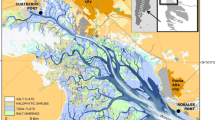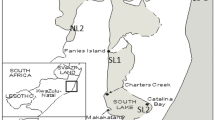Conclusions
Organisms from San Antonio Bay have been shown to have low heavy metal concentrations. This is most likely the result of low natural metal levels in the area and minimal man-introduced contamination due to the bay's location far from any dense industrial or population centers. In addition, vigorous shell dredging activity in the bay for more than 50 years has not in any obvious way increased the concentrations of heavy metals in the organisms found there.
Analyses have shown that metal concentrations in sediments from depths up to 2 meters (representing several centuries) are both low and uniform (Trefry, 1974). This indicates that the sediments do not represent any unusual metal reservoir for dredging to disturb, and shows that no recent increase in metal input to the bay has occurred.
In general, organisms from San Antonio Bay were lower in almost every metal than organisms from other areas where dredging and pollution are thought to be minimal. Molluscs were observed to concentrate metals more than the other organisms studied, but the levels observed are very much lower than those thought to be lethal or toxic (Bowen, 1966). Except for a few large fish, metal concentrations did not correlate significantly with the size or growth stage of the individual. In the fish, certain organs, such as the liver, were found to concentrate metals, in agreement with previous reports.
Similar content being viewed by others
References
BELLA, D. A., and J. E. MCCAULEY: Environmental considerations for estuarine dredging operations. Proc. World Dredging Conf. 457 (1972).
BOWEN, H. J. M.: Trace elements in biochemistry. Academic Presss, London, 241 pp. (1966).
BROOKS, R. R. and M. G. RUMSBY: The biogeochemistry of trace element uptake by some New Zealand bivalves. Limnol. Oceanogr.10, 521–527 (1965).
BROOKS, R. R., et al.: The APDC-MIBK extraction system for the determination of trace elements in saline waters by atomic absorption spectro-photometry. Talanta14, 809 (1967).
CARMODY, D. J., et al.: Trace metals in sediments of New York Bight. Mar. Poll. Bull. 4, 132 (1973).
HATCH, W. R., and W. L. OTT: Determination of sub-microgram quantities of mercury by atomic absorption spectrophotometry. Anal. Chem.40, 2085 (1968).
IDOE: Baseline studies of pollutants in the marine environment. Background papers for a meeting at Brookhaven National Laboratory, 24–26 May 1972.
KOFLER, F. W. (ed.): Copper and zinc content of oysters (Crassostrea virginica) from selected areas of the South Atlantic and Gulf of Mexico. USD HEW, Public Health Ser. Tech. Memo. GCSSRC (FY 67-1), 9 pp. Unpublished report (1966).
PRESLEY, B. J., et al.: A study program to identify problems related to oceanic environment quality-Gulf of Mexico and Caribbean (heavy metals), In: Baseline Studies of Pollutants in the Marine Environment (I.D.O.E.). 732. Brookhaven Nat. Lab., New York (1972).
PRINGLE, B. H., et al.: Trace metal accumulation by estuarine molluscs. Unpublished report (1967).
SEGAR, D. A., et al.: The distribution of the major and some minor elements in marine animals. Part II. Molluscs. J. Mar. Biol. Ass. U. K.51, 131 (1971).
STRICKLAND, J. D. H., and T. R. PARSONS: A practical handbook of sea water analysis. Fish. Res. Bd. Canada, 311 pp. (1968).
TREFRY, J. H.: The distribution of potentially toxic heavy metals in the sediments of San Antonio Bay and the Northwest Gulf of Mexico —M.S. Thesis, Texas A & M University, College Station, Tx. (1974).
VINOGRADOV, A. P.: The elementary chemical composition of marine organisms, In: Sears Found. for Mar. Res., Mem. II. Yale Univ., New Haven, 647 pp. (1953).
VOGEL, A. L.: A textbook of quantitative inorganic analysis. Longman Ltd., London, 1216 pp. (1971).
WINDOM, H. L.: Arsenic, cadmium, copper, lead, mercury, and zinc in marine biota-North Atlantic Ocean, In: Baseline Studies of Pollutants in the Marine Environment (I.D.O.E.). 121 Brookhaven Nat. Lab., New York (1972).
Author information
Authors and Affiliations
Rights and permissions
About this article
Cite this article
Sims, R.R., Presley, B.J. Heavy metal concentrations in organisms from an actively dredged Texas Bay. Bull. Environ. Contam. Toxicol. 16, 520–527 (1976). https://doi.org/10.1007/BF01685358
Issue Date:
DOI: https://doi.org/10.1007/BF01685358




